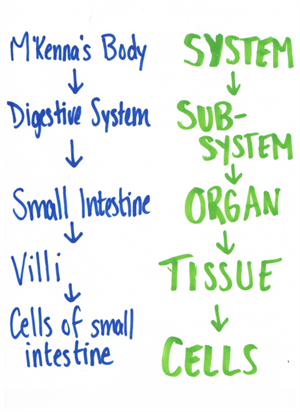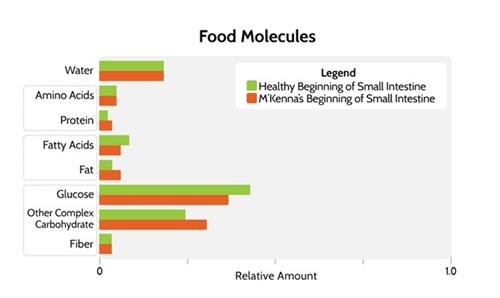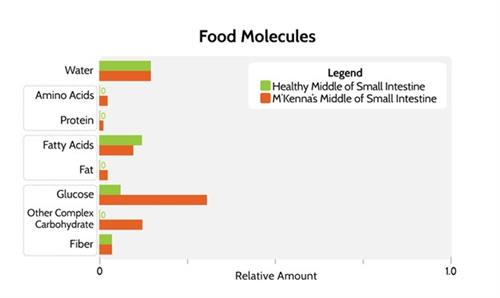- Heatherwood Middle School
- 7th Grade Science
-
Wednesday, January 15th
Posted by Parker Hansen on 1/15/2025True to my word this time, today we’ll be looking at conclusions from the villi simulation. Villi are tissue in the small intestine that aid in the absorption of nutrients. The cells act like doors, which allow smaller food molecules to pass through. The simulation was meant to steer students towards a few specific points:
- Villi height and percent of food molecules absorbed are directly related. This means that overall, as villi height increases so does absorption.
- This is because increasing the height of the villi increases the number of doors, or cells, that are lining the small intestine. A higher number of cells means more molecules can enter the bloodstream.
We take another look at the endoscopy images from several weeks ago and realize that M’Kenna’s small intestine is missing its villi. We discuss how this condition must be new, and how we’ve finally identified what’s causing the symptoms. What we don’t yet know, and what we’ll start discussing tomorrow, is what’s causing the villi to disappear.
-
Tuesday, January 14th
Posted by Parker Hansen on 1/14/2025Just a short update today because I was wrong about diving into the simulation results! It turns out everyone needed more time on the actual simulation. I’m more than happy to give them the time since they’re working hard and staying on tasks. We’ll push back looking at the results to tomorrow.
-
Monday, January 13th
Posted by Parker Hansen on 1/13/2025Welcome back! Today, we’re going to be taking a closer look at the small intestine. Before we do that, we need to formally address how the body is organized. We’ve been talking about system and organs for several weeks now. I like to use the example of mailing a letter or package. Without a complete address, the letter won’t arrive. The body is also organized:

We’ve discussed everything but tissue at this point in the unit. Villi, or the tissue in the small intestine, are today’s focus. Just like doors let people into and out of buildings, the villi are the mechanism for allowing nutrients to move from the small intestine to the bloodstream.
Students will be using this simulation to test different villi heights. They’re tracking how many cells are present and what percentage of food molecules are being absorbed. We’ll dive into the simulation results in more detail tomorrow.
-
Friday, January 10th
Posted by Parker Hansen on 1/10/2025Happy Friday! Just a small update today. We reviewed what we learned this week as well as before break with a review Kahoot. Next week, we’ll start investigating what exactly is going wrong with M’Kenna’s small intestine. Have a great weekend!
-
Thursday, January 9th
Posted by Parker Hansen on 1/9/2025Today, we tracked what’s happening to each food molecule as it moved through each organ in the digestive system. Students worked in pairs to look through different graphs. Their goal was to reach something along these lines:

The data allows us to notice and make claims about key pieces of data. It’s also going to serve as the definitive guide for what type of food molecules are absorbed where in the digestive system.
-
Wednesday, January 8th
Posted by Parker Hansen on 1/8/2025After our warm-up, groups had a little more time to wrap up their statements from yesterday. Then, we discussed the data together as a class. I wanted to highlight a few key idea from each graph.
- For the mouth, the levels of complex and simple carbohydrates do not match the amount initially in the graham cracker. This means that some form of digestion is starting from the moment food enters our mouths. Second, M’Kenna and the healthy person have the same levels here, which indicates nothing is wrong with M’Kenna’s mouth.
- For the small intestine, we start to see differences in the absorption rate between M’Kenna and the healthy individual. We already know the small intestine is the organ where a lot of issues are arising, so this makes sense. Secondly, there are now fatty and amino acids in the graphs, which weren’t present in the graham cracker. This means that the body is starting to break down lipids and proteins.
- For the large intestine, we see that no fiber is absorbed. This tracks with what we learned previously: our bodies don’t digest fiber. Second, M’Kenna has significantly more food molecules than a healthy individual.
We then talk about what happens to anything left over in the large intestine, as well as read a short article on saliva.
-
Tuesday, January 7th
Posted by Parker Hansen on 1/7/2025Today, we followed food molecules throughout the entire digestive system.
There is a graph for each organ in the digestive system that we’ll be focusing on. Students worked in their table groups to develop three observations per graph. They needed to explain what that observation meant as well. This took longer than I anticipated, which is totally fine. We’ll finish it up tomorrow and discuss patterns and trends.
-
Monday, January 6th
Posted by Parker Hansen on 1/6/2025Welcome back! I hope everyone had a great winter break! I wanted to ease everyone back into school routines today, so we didn’t dive right into new content. Instead, we started with our usual weekend check-in, but went a longer on account of all the time off. It was great to hear about all the different activities students were up to over the vacation.
Once the weekend check-in was done, we spent some much-needed time reviewing just what we covered prior to break. Students have a habit of forgetting some things after being gone for two weeks. With the help of our warm-up and student volunteers, we summarized the few weeks leading up to break.
This left us just enough time to dip our toes into something new. Prior to the break, we were tracking food molecules through the digestive system. We saw graphs of those food molecules as they moved through the small intestine. These graphs are what told us that M’Kenna’s body was having trouble absorbing nutrients, specifically carbohydrates. This led to a natural question: where are the food molecules that are absorbed going?


Using what we know about cells and other body systems, students worked in their table groups to reason out that those nutrients enter our blood, and are then transported throughout the body. Tomorrow, we’ll be looking at absorption throughout the entire digestive system.
-
Thursday, December 19th & Friday. December 20th
Posted by Parker Hansen on 12/19/2024We’ll be closing out the year with a movie. It’s a rare thing to watch one in science class, and the students have been working hard for four months. I hope everyone has a restful winter break, and I’m looking forward to diving back in to science in January!
-
Wednesday, December 18th
Posted by Parker Hansen on 12/18/2024Today was a WeVideo workday. Students had a goal to complete their projects by the end of period today. I’ve already watched some awesome videos!

